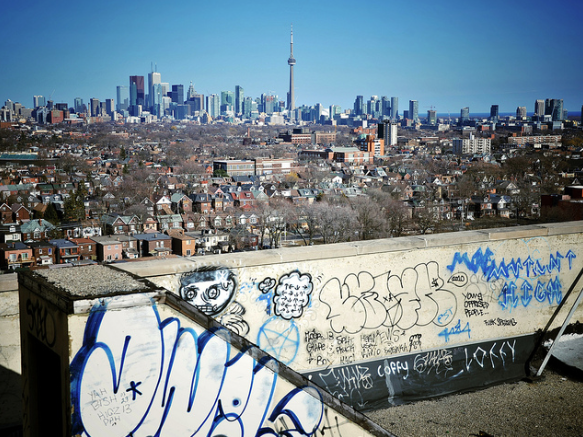Post by HLTD50 student ShalsHealth
To say that I am moved by Chimamanda Ngozi Adichie’s Ted Talk “The Danger of a Single Story” would be an understatement. In this lecture, Adichie talks about stereotyping and how today’s society tends to categorize individuals based off of a single story that we hear. Having lived in Scarborough for a chunk of my life, it is evident that it is a community and city that is so diverse; however, Scarborough can also easily be a victim of this categorization and stereotyping that Chimamanda speaks about. I am also guilty of stereotyping individuals and categorizing them based off of single stories that were told to me growing up. Viewing Chimamanda’s TED Talk showed me the importance of recognizing that there is danger of producing only one aspect of the story. This concept brought my attention to Catherine Hernandez’s novel Scarborough and what single story that she retells through her book. A city of people of colour, a city filled with diversity, and a city filled with struggle. Hernandez carefully displays diversity, culture and struggle as she ensures that the city of Scarborough is not misrepresented or portrayed in the wrong way.
*
When I was looking for a photo of Scarborough for my blogpost, I came across a 2015 post in Narcity called “10 Struggles of Living in Scarborough.” As I scrolled down, I started noticing what the blog was stating about Scarborough:
The commute is shit.
No one wants to visit you.
Everyone is scared of the RT. [Ed’s note: RT = rapid transit]. (Narcity, 2015).
These are just a taste of that blog’s content: a single, dangerous, off-putting story of Scarborough. I thought about the difference between that post and the picture Hernandez paints throughout her novel. The blogpost speaks about Scarborough as a place where everything feels lifeless — a “Wasteland”. It is notable that everyone is entitled to their own opinion, however, what actually goes on in this place that they call a wasteland? Who are these people that live here? And what struggles do they face on a day to day basis? These questions are what Hernandez uncovers through her novel. She accepts Scarborough as it is, digging deeper and describing Scarborough as a home through an insider perspective.
*
I admit that, reading Scarborough, it was challenging to encounter the story of a child who only owned 3 sets of clothes and who sometimes she had to turn her underwear inside out because of what her mother could not, and did not, provide. However, as I felt pity for Laura’s character, I somehow forgot my own past of coming with my mother to Scarborough 21 years ago, living in a small room and wearing clothes that kids often laughed at in school. Seeing my mother struggling with the language–she was a new immigrant with a 2-year-old, who knew nothing but to provide me a better life.
There were many times my mother and I were given opportunities to help us through the struggles we faced. My mom had the opportunity to learn the English language in Scarborough through LINC classes. Since she was also a parent I was put in daycare and taken care of until my mom had finished her classes. Much of the time, for many things we struggled with and many things my mom felt shamed for, there was a way through the institutions to help us. I remember when growing up, there was always a food and nutrition program at school, so even if I did not have a snack, they would provide snacks for the students at school. One thing that I realize when reading Scarborough is that the opportunity that they provide through the institutions without putting shame on the individual. Scarborough may not be the most luxurious region of Toronto, but like what Chimamanda states, it’s a danger and single story to say it is nothing but a wasteland. Through Hernandez’s novel readers are able to open another side to Scarborough. We are able to see the single stories of many individuals that are culturally diverse, and you realize how this city pushes through the shame and provides opportunities to the people in need.
*
The question that is still left lingering is how all of this relates to health and humanities? When I listened to Hernandez recite the chapter of Laura during our in-class visit (March 14, 2018), she talked about shame and how, as a frontline worker, you never want to put that shame on an individual. Hernandez states that it is important to provide service to individuals in need without shaming them. When providing services for a community that is less privileged, occasionally the individuals in need may feel shame in receiving that. This concept is very similar in the healthcare setting. The short memoir, “Travels to the Psych Ward,” by Gina Nicoll, speaks about a similar experience. In “Travels to the Psych Ward,” Nicoll is surprised by how she is received within the institution providing her with comfort and a homely feel within the setting, eliminating her shame and fear. In relation to Laura’s case, there might be shame on who’s watching her as she reaches for the food, in the case of the psych ward, there is this stigma or shame when approaching or asking for help through or at a psychiatric institution. In Laura’s case, she was lucky to have Ms. Hina who skilfully gives her the muffin without associating her without creating a scene of shame. Even if the opportunity is there, it’s not as easy to go get what you want easily. Most importantly, in both cases, the notion of shame is erased.
